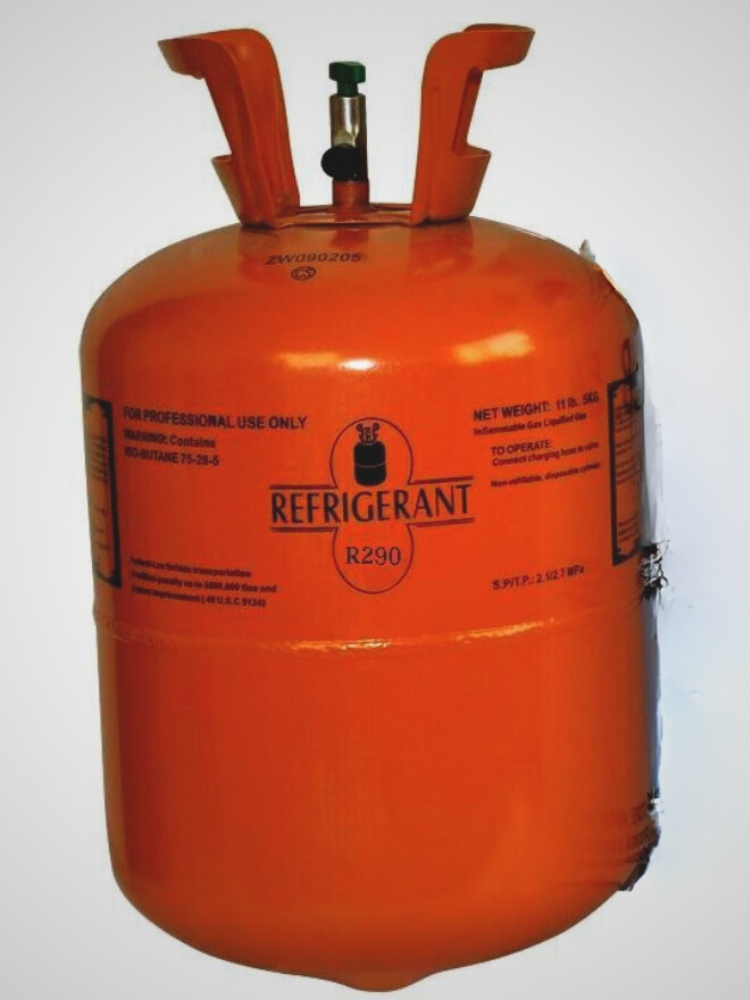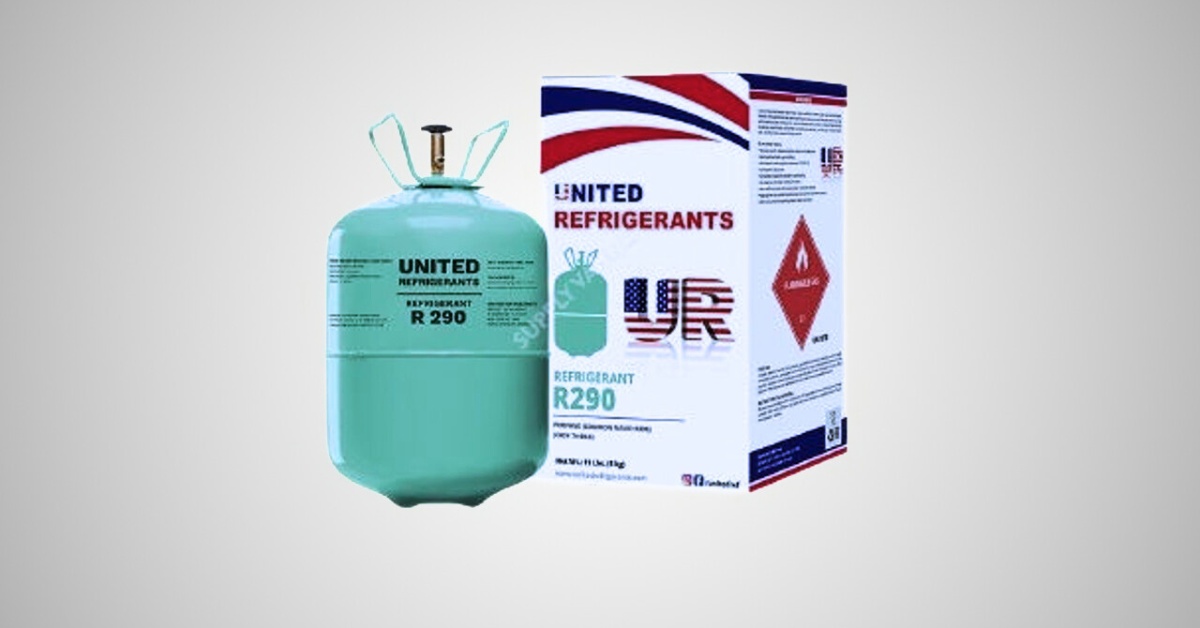Everything You Need to Know About R290 Refrigerant
R290 refrigerant is used on a smaller scale in AC units and heat pumps in homes and in industrial refrigeration. In 2011, the EPA said that small amounts of propane could be used in stand-alone retail refrigerators and freezers. Comparing R-290 systems to R-22 and R-134a systems of the same size, R-290 systems use 40 percent less refrigerant.
The refrigeration industry in the U.S. can now start to plan for the use of R-290 refrigerant systems with more of it. Even though there are some problems with using propane, it is becoming an increasingly attractive choice for companies that care about the environment. Even though new clarity in the regulatory environment should make it easier for R-290 to be used by more people.
What is R290 Refrigerant?
R290 is a propane-based refrigerant that is used in much commercial air conditioning and refrigeration units. It is very pure propane that is safe to use and doesn’t hurt the ozone layer. Because of these things, it is also the preferred alternative to hydrocarbons by the Environmental Protection Agency (EPA), and it can help companies reach their sustainability goals.



Not only is it good for the environment, but it is also very efficient, which can save energy over the life of the unit. In a study that used a mixture of R290 and R600a (both HFCs), the efficiency of home units went up by 28.5%.
Aside from R290, there are also other natural hydrocarbon refrigerants used in a wide variety of commercial refrigerators, freezers, and Air Conditioner units. Also, these don’t hurt the ozone layer and have a low GWP.
- R1270 is a refrigerant made of propylene that is used instead of R22 and R502.
- R600a is a refrigerant made of isobutane that takes the place of R12 and R134a.
R-290 is a hydrocarbon that only has one part. It is a byproduct of the process of refining natural gas and oil. The most important thing about propane is that it can catch fire. In the table below, you can see more things about R-290.
| Formula | C3H8 |
| Molecular weight (g/mol) | 44.1 |
| Boiling temperature °F (°C) | -43.8 (-42.1) |
| Critical temperature °F (°C) | 206.1 (96.7) |
| Critical pressure, PSI, (Bar) | 616.5 (42.5) |
| Global Warming Potential | 3 |
| Ozone Depletion Potential | 0 |
| ASHRAE Safety Group | A3 |
R290 Refrigerant Benefits
Due to its better thermodynamic properties, R290 refrigerant has a lower charge per system and uses less energy, which lowers the costs of running the system. Other benefits are:
Performance
R290 is a coolant that works well. R290 has already been used in many other types of commercial refrigeration without any problems, and the results have been great.
Eco-Friendly
R290 is a hydrocarbon (HC) refrigerant. This type of refrigerant is natural and non-toxic, and it is the best alternative to hydrofluorocarbon (HFC) refrigerants. Because it is good for the environment, it is likely to be used as a commercial refrigerant for a long time.
State Compliance
As of May 11, 2015, the EPA’s Significant New Alternatives Policy (SNAP) program says that class I and class II refrigerants used in the food service industry must be closely regulated. This includes the refrigerants used in commercial ice maker, reach-in freezers, air conditioners, and many other products. The EPA has also approved more refrigerants that have a low global warming potential (GWP) and changed some rules about how to get rid of old refrigerants.
R290 Refrigerant Drawbacks
R-290 is a refrigerant, and like any other, it has its pros and cons. Most of the problems that have kept it from being used have to do with the fact that it can catch on fire. This means that it has to be used in systems that meet regulations for being flameproof. Because of this worry, propane systems in the U.S. cannot have more than 150 grams of charge.
At least as recently as 2015, concerns were raised about how hard it would be to get it approved because of fire and building codes, as well as the fact that it can catch on fire and that low charge limits of 150g are set globally. Special handling rules and certifications were also seen as possible problems. Even after five years, many users still have trouble because there aren’t enough trained and certified field technicians.
But the fact that it can catch fire means that special devices to protect against high pressures and special arrangements for the electrical system are needed for it to be used safely. It also means that new ways must be found to use it in more places than just stand-alone display cases, like the chilled-loop systems in Norway and the United States.
On the plus side, propane can be used in plants at medium and low temperatures with almost no extra equipment. Since this is the case, it is possible that the industrial use of propane in the United States could grow a lot as more people learn about its benefits.
At this point, it seems that loop system technologies need to improve more before they can be used in retail food stores in a much bigger way. In the meantime, though, more and more users are seeing the benefits of stand-alone apps for individual display cases. Most of the time, these units come with wheels so that they can be moved around the store. Otherwise, all you need is an outlet to plug them into. As of 2017, U.S. regulators were talking about raising the current 150g charge limit for R-290 applications to 300g. Doing so would probably move the use of propane forward a lot.
R290 Refrigerant Replacement
Most of the United States is just starting a R290 refrigerant repplacement, but it has been used in Europe for more than 20 years. The phase out date of R404a refrigerant is on January 1, 2020. Since then, many states have pledged their own actions.
- R290 Refrigerant Replacement in 2020-2021: California, Colorado, Delaware, Maryland, Massachusetts, New Jersey, New York, Vermont, and Washington
- R290 Refrigerant Replacement in 2022: Maine, Rhode Island, Virginia, All Provinces & Territories of Canada
Is R290 Refrigerant Flammable?
People worried that these propane-powered refrigerators could explode, but studies have shown that this is less than a.001 percent chance, even in gas-powered kitchens. In fact, most R290 units have less propane than common items like lighters, air fresheners, and spray paint. Systems that use R290 can also vent the refrigerant into the air, so it doesn’t have to be recovered. Please keep in mind that R290 can only be used on brand-new equipment and can’t be added to older machines.
ASHRAE has designated R-290 as a class A3 refrigerant, its highest flammability classification.
Conclusion
R290 refrigerant has been used in refrigeration plants around the world for many years, mostly in industry. It is a proven refrigerant. R290, on the other hand, is used in smaller, more compact systems with low refrigerant loads, like heat pumps and air conditioners for homes. Also, the number of commercial refrigeration systems and chillers that use it is on the rise.
Propane can also be mixed with either isobutane (R600a) or ethane (R170) to make it work like halocarbon refrigerants. Most of the time, pure isobutane is used in small systems as a replacement for R12. The problem with hydrocarbons is that they are very flammable, so they are put in the safety group A3 for refrigerants. Based on how often a certain amount of refrigerant is used in commercial systems, the design and risk analysis of the system must be in line with regulations for explosion protection.

